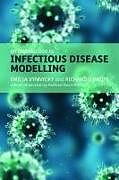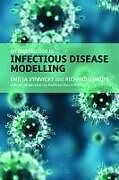An Introduction to Infectious Disease Modelling
Einband:
Kartonierter Einband
EAN:
9780198565765
Untertitel:
Englisch
Genre:
Medizin
Autor:
Emilia Vynnycky, Richard White
Herausgeber:
OUP Oxford
Anzahl Seiten:
400
Erscheinungsdatum:
15.07.2010
ISBN:
978-0-19-856576-5
Mathematical models are increasingly being used to examine questions in infectious disease control. Applications include predicting the impact of vaccination strategies against common infections and determining optimal control strategies against HIV and pandemic influenza. This book introduces individuals interested in infectious diseases to this exciting and expanding area. The mathematical level of the book is kept as simple as possible, which makes the book accessible to those who have not studied mathematics to university level. Understanding is further enhanced by models that can be accessed online, which will allow readers to explore the impact of different factors and control strategies, and further adapt and develop the models themselves. The book is based on successful courses developed by the authors at the London School of Hygiene and Tropical Medicine. It will be of interest to epidemiologists, public health researchers, policy makers, veterinary scientists, medical statisticians and infectious disease researchers.
This book has grown out of the experience of the authors teaching such a course for several years at the London School of Tropical Medicine and Hygiene. The Contents are very comprehensive, with chapters on basic terminology concerning infections and transmission, models based on difference equations, models based on differential equations, basic output from models, age patterns, stochastic modelling, contact patterns, models for sexually transmitted infections, some special topics (varicella vaccination and boosting, serotype replacement, tuberculosis control, HIV/STI co-infection) and an appendix on mathematical matters. The basic ideas are illustrated by many examples and case studies, among which several related to very up to date research and references. All relevant keywords and modern catchwords related to infectious disease modelling are mentioned and explained.
Autorentext
Emilia Vynnycky obtained a BA in Mathematics from Oxford University, followed by an MSc in Operational Research from Southampton University and a PhD in Infectious Disease Modelling at the London School of Hygiene and Tropical Medicine (LSHTM), where she subsequently worked as a Lecturer until 2003. She is now senior scientist in the Modelling and Economics Unit at the Health Protection Agency (HPA), Centre for Infections. Emilia has worked on modelling the transmission and control of several different infectious diseases including tuberculosis, rubella, pandemic and seasonal influenza, measles and HIV. Emilia has also led the development of the LSHTM/HPA Infectious Disease Modelling MSc module and summer short course since its inception in 2001 with Richard White, and is currently an honorary Lecturer at LSHTM. Richard White obtained a BSc (Physics) from Durham University and an MSc (Medical Demography) and PhD (Infectious Disease Modelling) from the London School of Hygiene and Tropical Medicine. He is now Senior Lecturer in Infectious Disease Modelling in the Centre for the Mathematical Modelling of Infectious Diseases at LSHTM and a Medical Research Council Methodology Research Fellow. Richard has worked extensively in recent years using mathematical modelling and classical epidemiological techniques to understand the epidemiology and control of sexually transmitted infections/HIV and other infectious diseases in developing countries. Richard is currently involved in modelling projects on the transmission and control of many infectious diseases including HIV, tuberculosis, herpes simplex virus-2, influenza, human papillomavirus and rift valley fever, in places as diverse as Senegal and Soho. He is associate editor of the journal Sexually Transmitted Infections.
Klappentext
This book will provide public health and infectious disease researchers with the tools to use and critically evaluate the mathematical models that are increasingly being used to interpret and predict the dynamics and control of infectious diseases.
Inhalt
Preface
Abbreviations and GlossaryCommonly used symbols
1: Introduction: the basics - infections, transmission and models
2: How are models set up? I. An introduction to difference equations
3: How are models set up? II. An introduction to differential equations
4: What do models tell us about the dynamics of infections?
5: Age patterns
6: An introduction to stochastic modelling
7: How do models deal with contact patterns?
8: Sexually transmitted infections
9: Special topics in infectious disease modelling
Appendix
Basic maths
Further reading
Useful equations

Leider konnten wir für diesen Artikel keine Preise ermitteln ...
billigbuch.ch sucht jetzt für Sie die besten Angebote ...
Die aktuellen Verkaufspreise von 6 Onlineshops werden in Realtime abgefragt.
Sie können das gewünschte Produkt anschliessend direkt beim Anbieter Ihrer Wahl bestellen.
Loading...
Die aktuellen Verkaufspreise von 6 Onlineshops werden in Realtime abgefragt.
Sie können das gewünschte Produkt anschliessend direkt beim Anbieter Ihrer Wahl bestellen.
| # | Onlineshop | Preis CHF | Versand CHF | Total CHF | ||
|---|---|---|---|---|---|---|
| 1 | Seller | 0.00 | 0.00 | 0.00 |
